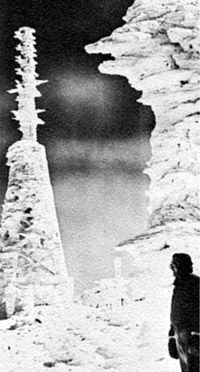Scott's pioneering designs in Wide-band FM tuners were vital in helping the
early commercial FM broadcasting industry reach broader audiences in the 1950's. From Mt.
Washington, New Hampshire, (site
of the world's worst weather) to Mt. Wilson, California, the legendary H.H. Scott Type
310 FM Wide-band Broadcast Monitor (tuner) was used in relay links (similar conceptually
to modern FM translator stations) to extend the limited coverage of
"line-of-sight" commercial FM transmitters.
By remotely locating the relay transmitters and antennas high
atop rugged mountains, often in extremely adverse conditions, early FM broadcasters
were able to reach much broader "network" audiences in the rural communities of
Northern New England and Canada, rather than the limited metropolitan coverage areas
of Boston. (see additional article on John Shepard's First FM
Network by Donna Halper).
The Scott tuners were so stable and sensitive that they were used
to receive "over-the-air" FM signals broadcast by the studio in some cases, over
130 miles away. The Scott tuner's audio was then fed directly into the mountain top FM
transmitter for relay broadcasting to the much broader geographical region.
According to Parker H. Vincent, then Chief Engineer of
WMTW-FM, "the 310 tuner
has given eminently satisfactory results; we believe this to be one of the longest
successful re-broadcast hops ever."
The Apparatus Development Company, manufacturers of the
"FM/Q" antenna, reports: "The Scott 310 consistently receives signals
from a distance of 510 miles. This is the best record of any FM tuner in our files."
As a point of fact, the Scott marketing moniker "Broadcast
Monitor," was well deserved. Scott tuners were extremely sensitive, and once fully
warmed up, did not drift off station. This was frequently a major problem for other FM
tuner manufacturers of the era. Some tuner models of the Scott line, even introduced
"diversity" reception to reduce multi-path distortion by using multiple antenna
inputs. The reliability of the H.H. Scott tuners was legendary. They were simply left
continuously on, (24 hours by 7 days a week), except for normal maintenance, which
consisted of routine tube replacement.
Today, all the once-rural communities in New England and Southern California
sport their own FM stations, and we take FM Stereo multiplex broadcasting for granted. We
enjoy our FM stereo stations, and most of us have probably forgotten the early days of
pioneer FM broadcasting when we heard true high fidelity/stereo radio broadcasts for the
first time. The FM Stereo multiplex standard which H.H. Scott helped popularize has
weathered the test of time.
Editor's Note: I'll never forget hearing, in 1962, my first fully FM stereo
multiplex broadcast on my father's Scott 310-C/335 using Koss Stereophones. I was
listening to KSOM-FM (Salem, Ohio) and heard "76 Trombones," from M.
Wilson's Broadway production, "The Music Man." It was such an
major improvement over the earlier primitive simulcast AM/FM "stereo" broadcast
experiments. Finding any station broadcasting in FM multiplex stereo in those days made it
all worth while!
Almost 40 years later the sweet and silky sound of a properly
aligned Scott tube stereo tuner is amazing, especially given the digital processing
of programming material coming from most of today's FM stations.
